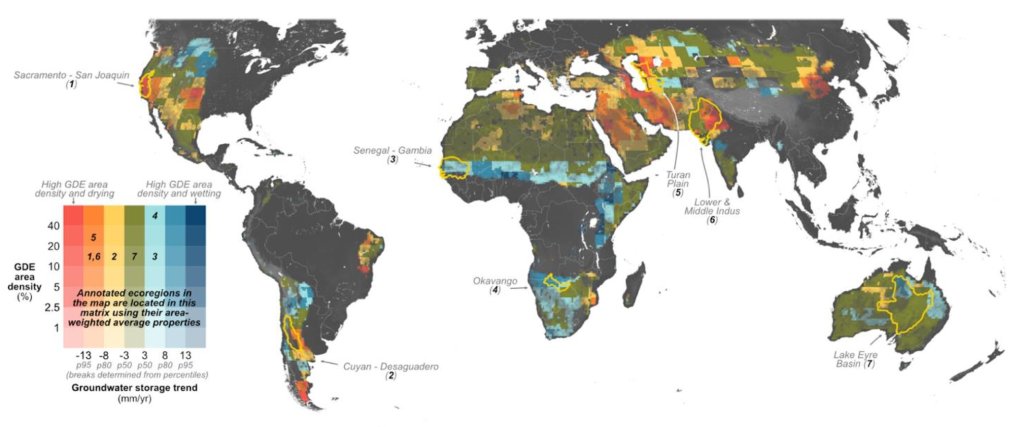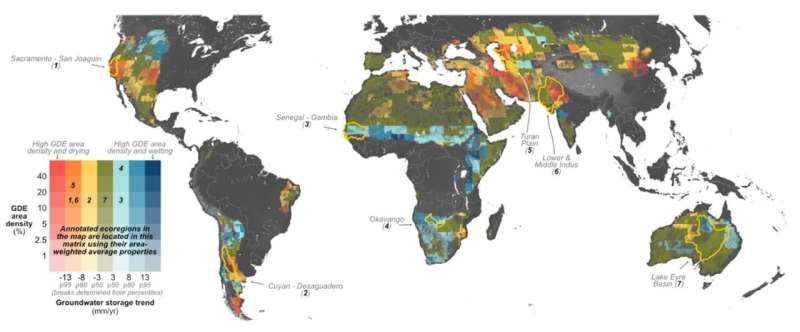
New research identifies ecosystems that could be threatened by declining groundwater levels (Image Credit: Phys.org)

Where hidden water tables meet the Earth’s surface, life can thrive even in the driest locations. Offering refuge during times of drought, shallow groundwater aquifers act like water savings accounts that can support ecosystems with the moisture required to survive, even as precipitation dwindles.
As climate change and human water use rapidly deplete groundwater levels around the world, scientists and policy makers need better data for where these groundwater-dependent ecosystems exist.
Now, a new study maps these ecosystems in dryland regions globally, examines their protection status, and explores how they overlap with human communities.
The research, published July 17 in Nature, is the first time that groundwater-dependent ecosystems have been mapped on a global scale. Led by scientists from The Nature Conservancy and the Desert Research Institute (DRI), the global effort brought researchers together from universities, non-profit organizations, and institutions from seven countries.
Their results show that 53% of these ecosystems are in areas with known groundwater depletion, while only 21% exist on protected lands or regions with policies in place for their protection.
“Until now, the location of these ecosystems has been largely unknown, hindering our ability to track impacts, establish protective policies, and implement conservation projects to protect them,” says Melissa Rohde, Ph.D., ecohydrologist and environmental consultant who is the lead author on the study.
Rohde completed the research as part of her doctoral dissertation at the State University of New York’s College of Environmental Science and Forestry and her joint work at The Nature Conservancy.
Ecosystems that depend on groundwater vary widely, Rohde notes, from desert springs, to mountain meadows and streams, to coastal wetlands and forests. These ecosystems are often hot spots for biological diversity worldwide, and are under increasing threat from climate change and human exploitation.
When Rohde’s colleagues at The Nature Conservancy offices around the world set out to conserve them, they found themselves running into a persistent lack of data—catalyzing Rohde’s mapping effort. “These ecosystems encompass these places we really care about, but their reliance on groundwater has been unacknowledged,” she says.
Using technology to advance the science of groundwater-dependent ecosystems
Without a global dataset for the location and depths of groundwater, the research team had to get creative.
They gathered six years of data from NASA’s Landsat satellite, which provides satellite imagery that can be used to estimate leaf water content, evapotranspiration, vegetation greenness, open water, and land temperatures and climate data that characterizes water availability. Then, they used more than 30 thousand data points of confirmed groundwater-dependent ecosystem locations to train a computer model how to identify them based on the satellite data.
“Our team at DRI had been using satellite remote sensing data to locate and characterize changes in groundwater-dependent ecosystems across the western US for many years, and this was the perfect opportunity to expand this work globally,” says Christine Albano, Ph.D., ecohydrologist at DRI.
The analysis takes advantage of the fact that an ecosystem supported by groundwater will remain greener, cooler, and wetter than other places throughout the dry season, and this can be seen with satellite imagery.
“Our approach leverages what we already know about the characteristics of these ecosystems,” Rohde says, noting that the way groundwater cools the ground surface is just one of the many ways that these ecosystems provide refuge to plants and animals.

“It continues to amaze me that we now have the data and technology to capture and analyze information for places the size of a basketball court or a swimming pool, and that we can do this across the entire globe,” says Albano.
“Having this level of spatial detail is critical for this analysis, because it is often the groundwater-dependent springs or wetlands that are about this size, or even smaller, that are the most critical to people and wildlife.”
The result is a global map of where ecosystems dependent on groundwater existed from 2015–2020, combined with a statistical likelihood of the researchers’ confidence in each location’s groundwater dependence.
“A few years ago, an analysis like this would not have been possible, but we can now leverage recent advances in machine learning and cloud computing to fill critical knowledge gaps for conservation at a global scale,” says Kirk Klausmeyer, Director of Data Science for The Nature Conservancy in California and co-author of the study.
By testing the computer model’s ability to identify known groundwater-dependent ecosystems, they estimate accuracy at around 87%.
“The intention of our map is that it be used as a starting point,” Rohde says. “It provides essential information on where they are likely located and most at risk of groundwater depletion, so that we can advance the protection of these biologically diverse ecosystems, and the societies dependent upon them.”
The map shows these ecosystems are more intact and extensive in Central Asia, the Sahel region of Africa, and South America, where pastoral communities are common. This contrasts with their depletion and fragmentation in parts of the world where groundwater pumping and agricultural irrigation reign, such as North America and Australia.
In the latter regions, many of these ecosystems have already been lost, as groundwater tables fall below the level where plant roots or streams can reach them.
Overcoming conservation challenges
To illustrate the role of these ecosystems in supporting rural livelihoods, the study also focused on the Greater Sahel region of Africa, where four conflict hotspots overlap with locations containing a high number of groundwater-dependent ecosystems.
Climate change is exacerbating food insecurity in these locations, resulting in expanded crop cultivation into previously pastoral lands, demonstrating the importance of recognizing the complex interactions of climate change and land and water conservation efforts.
“These ecosystems have a direct impact on the rural livelihoods of pastoralists,” Rohde says.
“While sustainable groundwater management policies may be politically tractable in some regions, humanitarian assistance that protects ecosystems for sustaining rural livelihoods or reducing conflict might be more appropriate in other regions. There needs to be creative solutions to preserving these ecosystems, and that’s going to vary a lot depending on where you are in the world.”
Despite the study’s determination that 21% of groundwater-dependent ecosystems are under some level of protection, Rohde’s other research has demonstrated that very few ecosystems are effectively protected where legislation exists. Without a better understanding of how groundwater is supporting ecosystems, even protected lands could be undermined if groundwater is lost due to unsustainable use outside protected boundaries.
“We need to acknowledge that groundwater is critical for many ecosystems,” Rohde says.
“Groundwater is being pumped at rates higher than it can be replenished, but we aren’t managing or regulating it to the extent necessary to prevent further ecosystem impacts. If we want to achieve our global biodiversity goals and our climate goals, then we need to connect the dots between groundwater and ecosystems.”
More information:
Melissa Rohde, Groundwater-dependent ecosystem map exposes global dryland protection needs, Nature (2024). DOI: 10.1038/s41586-024-07702-8. www.nature.com/articles/s41586-024-07702-8
Journal information:
Nature
Provided by
Desert Research Institute
New research identifies ecosystems that could be threatened by declining groundwater levels (2024, July 17)
retrieved 18 July 2024
from https://phys.org/news/2024-07-ecosystems-threatened-declining-groundwater.html
part may be reproduced without the written permission. The content is provided for information purposes only.





